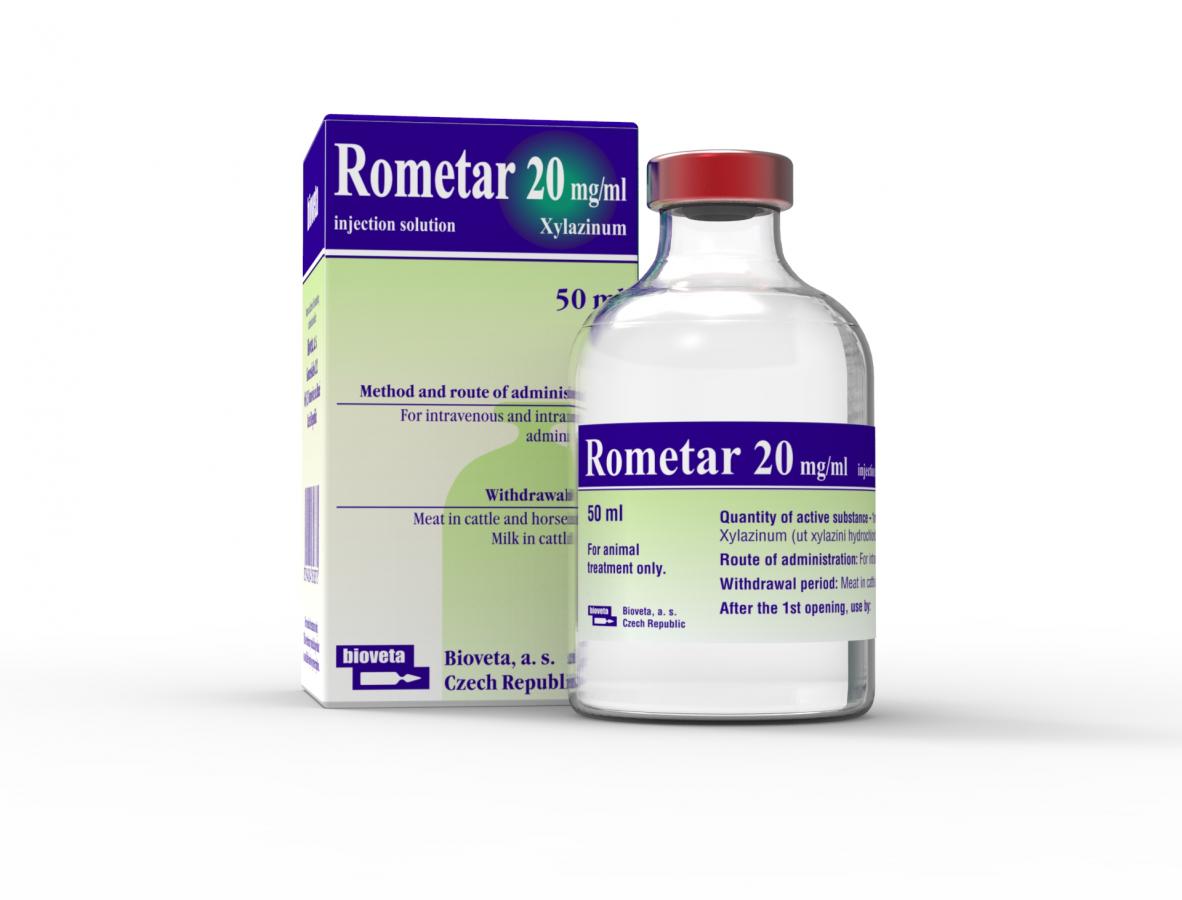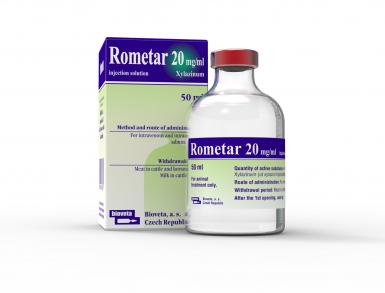ROMETAR 20 mg/ml injection solution
Homepage Products Veterinary products ROMETAR 20 mg/ml injection solution
Product for sedation, analgesia and muscle relaxation of animals containing xylazine
| type of preparative: | Analeptic, anaesthetic, hypnotics |
|---|---|
| target species animals: | Cattle, Horse, Cat, Dog |
Pharmaceutical form
Injection solution.
Clear colourless solution with no visible particles.
Composition
Xylazinum (ut xylazini hydrochloridum) 20 mg
Indication
Sedation prior to medical examination or not very painful procedures (transfer, weighing, X-raying, cloven hoof treatment, foreign matter removal from the throat of a big animal, ...).
Prior to painful procedures in combination with local anaesthetics (e.g. for dishorning, treatment of panaritium, Caesarean section). Use in cattle: alone, at higher doses, for medium or rather demanding procedures. Use in other animals: in combination with analgesics, hypnotics, injection anaesthetics and myorelaxants. Reduced doses of both xylazine and the anaesthetic are applied when used together.
Target animals
Horses, cattle, dogs, cats, ZOO animals (red deer, roe deer, fallow deer).
Dosage and application
Posology depends on the animal species, route of administration and required depth of the effect. The effect of xylazine can be extended by re-administration of one-third to one-half of the initial dose.
Horse: Use Rometar alone at doses of 0.6 to 1 mg xylazine per kg live weight (i.e. 3-5 ml Rometar/100 kg live weight). Administer the dose intravenously slowly. Too fast i.v. administration can induce temporary hypotension and excitation. Sedation (of individual intensity) occurs during the peak period, i.e. in 2-5 minutes after the i.v. administration. Myorelaxation manifested by ataxia and very slight analgesia only occurs if a dose near the upper limit was used. The sedative effect may be insufficient in agitated, upset and nervous horses.
The effect of the product lasts 20 to 30 minutes and vanishes in 60 minutes.
The effect is usually weak if xylazine was administered intramuscularly at doses of 7.5 to 10 ml/100 kg,
If the standing or lying patient is to undergo painful examination, treatment or surgery, the product should be co-administered with analgesics, hypnotics, and injection or inhalation anaesthetics. The combination which is most frequently used for short procedures on a lying patient is as follows: xylazine 1.1 mg/kg live weight slowly i.v., in 2-3 minutes followed by ketamine 2.2 mg/kg live weight rapidly i.v. The animal will lie down spontaneously in 45 seconds to 3 minutes. Anaesthesia lasts for a time which can be very different, from 4 to 30 minutes. It can be extended by administering one-third to one-half of the initial doses at the moment when signs of awakening appear.
If the product is combined with chloral hydrate, administer 3 to 4 ml of Rometar per 100 kg live weight and 4 to 6 g of chloral hydrate per 100 kg live weight. In order to induce overall injection anaesthesia for short procedures or to initiate inhalation anaesthesia, administer 0.5 to 0.8 mg xylazine per kg live weight i.v., in 3 to 5 minutes followed by guaifenesin 8 to 10 g per 100 kg live weight rapidly and strictly i.v., immediately followed by thiopental 4 to 6 per kg live weight i.v.
Cattle: Intramuscular administration is preferred. If i.v. administration is applied, the i.m. dose is reduced by one-third to one-half and slow injection is applied. The intramuscular dose depends on the desired intensity of the effect.
Dose I: 0.25 ml Rometar/100 kg live weight i.m. – sedation to calm the animal down and for minor procedures in local anaesthesia.
Dose II: 0.5 ml Rometar/100 kg live weight i.m. – medium sedation, weak relaxation and analgesia. The patient is allowed to lie down.
Dose III: 1 ml Rometar/100 kg live weight i.m. : very strong sedation with appreciable depression of the CNS, long-lasting myorelaxation and medium analgesia, well suited to the majority of surgeries on a lying patient (local anaesthesia can be applied in addition if appropriate).
Dose IV: 1.5 ml Rometar/100 kg live weight i.m. – induces total anaesthesia with pronounced side effects (bradypnoea, bradycardia, tympanites, salivation). This dose is rarely applied.
The sedative effect of Rometar in cattle starts, in dependence on the dose and route of administration, in 5-10 minutes following i.m. administration and in 1-3 minutes following i.v. administration, and lasts for a time from 30 minutes to a few hours.
Analgesia and myorelaxation lasts 45 to 90 minutes.
Dog: For sedation: 1 to 3 mg xylazine per kg live weight (i.e. 0.05 to 0.15 ml Rometar per kg live weight) i.m. following 24 hr starvation and premedication with atropine 0.05 mg per kg live weight s.c. or i.m. Doses near the lower limit are used in patients that are old, obese, with appreciable weight and with poor health. Tympanites may occasionally develop in dogs of big breeds (Great Dane, mastiff, basset). In combination with local or systemic injection and inhalation anaesthetics for painful examinations, treatments and surgeries. When used in a combination, the doses of Rometar as well as of the anaesthetic should be reduced to one-half or one-third.
Cat: For sedation: 1 to 2 mg xylazine per kg live weight (i.e. 0.05 to 0.1 ml Rometar/100 kg live weight) s.c. or i.m. (doses near the upper limit induce respiratory depression) after 24 to 36 hours of starvation and premedication with atropine (starvation and premedication must not be omitted). Vomiting or urge to vomit are frequent during the starting phase of the effect.
In combination with injection anaesthetics (typically ketamine) for inducing total anaesthesia in preparation for the majority of surgeries.
Red deer: Intramuscular administration of 1-2 mg xylazine per kg live weight (i.e. 0.05 to 0.1 ml Rometar per kg live weight) induces strong sedation in 10 to15 minutes. Doses of 3-4 mg xylazine per kg live weight i.m. induce immobilisation of the animal for 40 to 60 minutes.
Roe deer: The roe deer is highly sensitive to xylazine. Doses of 0.5 to 1 mg xylazine per kg live weight (i.e. 0.025 to 0.05 ml Rometar per kg live weight) i.m. induce deep sedation and frequently also immobilisation. Immobilisation will be achieved reliably with doses of 1.5 to 2 mg xylazine per kg live weight i.m.
Fallow deer, mouflon: Fallow deer is more resistant to xylazine, and so a dose as high as 6 to 10 mg xylazine per kg live weight (i.e. 0.3 to 0.5 ml Rometar per kg live weight) i.m. must be used to immobilise the patient. Administration: subcutaneous, intramuscular, intravenous.
Storage
Store below 25°C.
Protect from light.
Withdrawal period
Meat from cattle and horses: 1 day.
Milk from cattle: No withdrawal periods.
Do not use in other animal species whose meat is intended for human consumption.
Shelf life
Shelf-life of the veterinary medicinal product in an intact package: 2 years.
Shelf life after the first opening of the immediate packaging: 28 days.
Package
50 ml.










